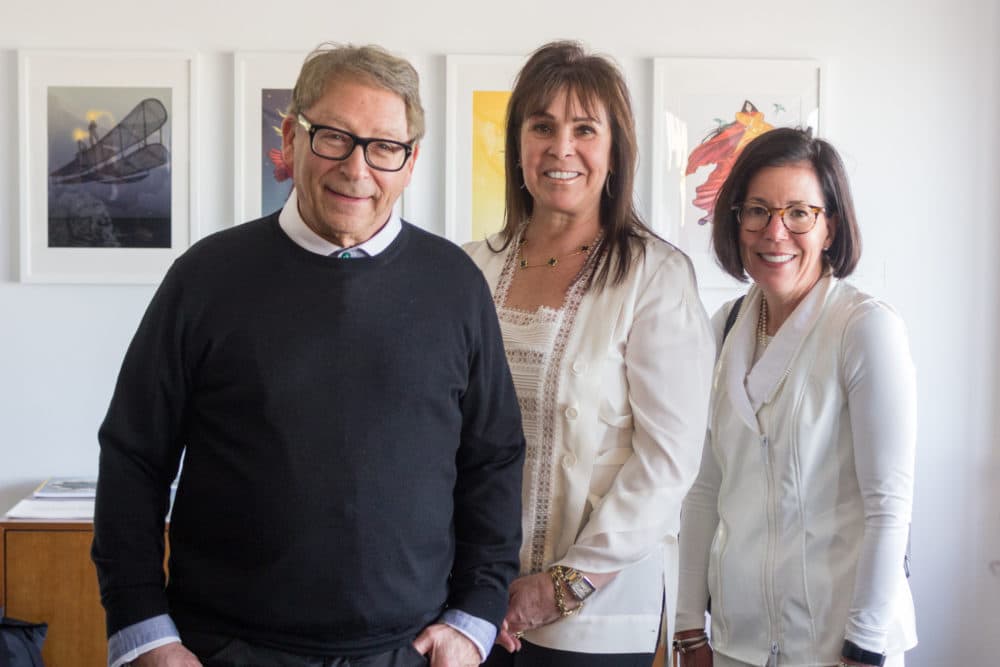Advertisement
Iconic Shoe Designer Stuart Weitzman Recalls His Start In Haverhill

The Robert Frost poem “The Road Not Taken” has been central for Stuart Weitzman’s global shoe empire. Frost’s poem presents two roads in the woods and the narrator embarks down, as the title suggests, the one most people forego.
On Tuesday evening, Weitzman spoke to a crowd at the Massachusetts College of Art and Design about his business and its longevity, which he attributes to going against the fashion industry’s conventional wisdom and, simply, trusting his gut.
“It’s the way I ran my business and a bit of my life, too,” Weitzman said, in an individual interview, of Frost’s poem. This instinctive decision making is evident in decisions like providing shoes to television actresses.
Years ago, an associate suggested Weitzman forego providing custom shoes for television stars and focus solely on movie stars, with more hollywood caché. His high-end shoes were wasted on low-level television stars, argued the associate. Weitzman resisted.
Instead, he provided shoes to then television actress Meghan Markle, long before she was a world-famous duchess. “You just never know where people end up,” he said. “Nobody could have ever imagined Meghan would end up where she is now.”
Michelle Obama, Kendall Jenner, and Selena Gomez are other A-list stars who’ve been photographed in Stuart Weitzmans. Beyonce said in a video honoring Weitzman’s lifetime achievement that she “literally danced a million miles in his beautiful shoes.”
Throughout his decades in a fleeting industry, Weitzman has managed to stay relevant in a fast-paced and unforgiving industry. Today, his shoes are sold in more than 70 countries.
In February, officials from the University of Pennsylvania announced the School of Design was taking Weitzman’s name. He graduated from the Wharton School at the University of Pennsylvania in 1963.
You can find Stuart Weitzman shops inside luxury malls or on glamorous streets like 5th Avenue in New York City, but the designer’s roots go back to Haverhill, Massachusetts, once a booming shoe factory town. It was in the 1960s when Weitzman started making shoes at his father’s Haverhill shoe factory, Seymour Shoes.
“I can say that was my schooling because this is where I learned shoemaking,” Weitzman said. Wietzman worked with his father until he died. Then he continued to work with his brother at the factory and spent 12 years selling the shoes and learning how to manufacture a product with consistency and quality.
“It’s a very technical industry,” he added. “It’s not like making a shirt or a dress that you can take in or let out.” Seymour Shoes is also the place Weitzman figured out what kind of product he wanted to sell and crafted a plan to slowly build a business.
“I was building a business a little bit at a time, and I always felt it didn’t matter how slow I was going as long as I kept going,” he said. “I found a niche that opened the door to take the company, first nation wide, then worldwide.”
The turning point for Stuart Weitzman, the company, was when Mulholland Drive actress Laura Harring walked the red carpet at the Academy Awards in the “Million Dollar sandals,” the heels of which were adorned with 464 diamonds. As the name suggests, the shoes were valued at $1 million.
“This opened the door to introduce our shoes to the best retailers around the world,” he said. “We were playing the game.” Weitzman then became known for comfortable, stylish women’s shoes — shoes a lawyer could put on for either work or a wedding and feel she was wearing something beautiful.
After some 60 years in the shoe business, Weitzman will fully retire at the end of the year from his position as Chairman Emeritus of the company, which he first sold in 2013. For the next generation of designers, Weitzman implores them to stay imaginative and prioritize strategic partnerships. His wildly successful run is due, in part, to his work with creative luminaries, such as photographer Mario Testino and late architect Zaha Hadid.
Imagination is most important, he said. One doesn’t have to work in fashion — or even be interested in it — to glean wisdom from Weitzman’s career. “People can look to him and see the ways he sought opportunity,” said Sondra Grace, who chairs the Fashion Department at Massachusetts College of Art and Design. “Shoes happen to be an everyday product, but he made them part of an ensemble.”